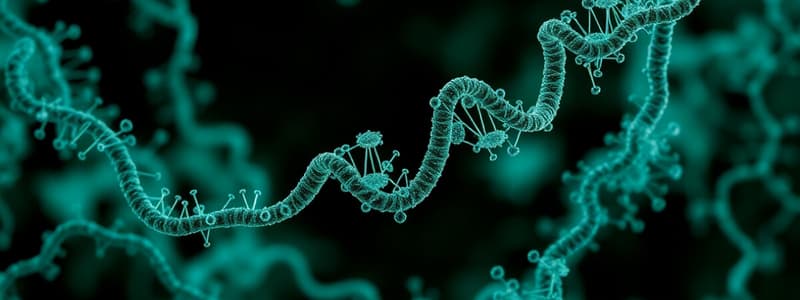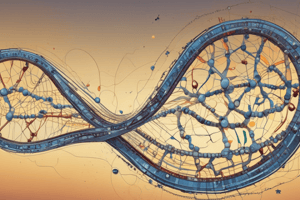Podcast
Questions and Answers
Which of the following scenarios best illustrates the principle of homeostasis?
Which of the following scenarios best illustrates the principle of homeostasis?
- A plant growing taller in response to increased sunlight exposure.
- A mammal maintaining a constant body temperature despite fluctuations in the external environment. (correct)
- A bacterium dividing into two identical daughter cells.
- A population of insects developing resistance to a pesticide over several generations.
Which of the following best describes how the process of natural selection leads to adaptation?
Which of the following best describes how the process of natural selection leads to adaptation?
- Organisms with traits that increase their survival and reproduction become more common in a population over time. (correct)
- All organisms in a population acquire the same beneficial traits simultaneously.
- Environmental changes directly cause mutations that benefit the affected organisms.
- Organisms learn new behaviors during their lifetime and pass these on to their offspring.
Which statement correctly links a biological process with its energy source?
Which statement correctly links a biological process with its energy source?
- Cellular respiration uses light energy to produce glucose.
- Cellular respiration breaks down glucose to release energy in the form of ATP. (correct)
- Photosynthesis uses chemical energy to produce ATP.
- Photosynthesis breaks down ATP to create glucose.
How do mutations contribute to the process of evolution?
How do mutations contribute to the process of evolution?
Which of the following describes the relationship between a community and an ecosystem?
Which of the following describes the relationship between a community and an ecosystem?
How does the structure of a phospholipid molecule contribute to the structure of cell membranes?
How does the structure of a phospholipid molecule contribute to the structure of cell membranes?
Which of the following best explains the role of enzymes in biological reactions?
Which of the following best explains the role of enzymes in biological reactions?
How do the processes of transcription and translation work together to produce proteins, as described by the central dogma of molecular biology?
How do the processes of transcription and translation work together to produce proteins, as described by the central dogma of molecular biology?
Consider a scenario where a population of birds is exposed to a new disease. Some birds have a genetic resistance to the disease, while others do not. How would natural selection likely affect this population over time?
Consider a scenario where a population of birds is exposed to a new disease. Some birds have a genetic resistance to the disease, while others do not. How would natural selection likely affect this population over time?
Why is biodiversity important for the stability and resilience of ecosystems?
Why is biodiversity important for the stability and resilience of ecosystems?
Flashcards
What is Biology?
What is Biology?
The scientific study of life, covering molecular mechanisms to ecosystem interactions.
Cell Theory
Cell Theory
All living organisms are composed of cells, the basic units of life.
Gene Theory
Gene Theory
Hereditary information is encoded in DNA and genes passed from parents to offspring.
Evolution
Evolution
Signup and view all the flashcards
Homeostasis
Homeostasis
Signup and view all the flashcards
Organization (in Biology)
Organization (in Biology)
Signup and view all the flashcards
Response to Stimuli
Response to Stimuli
Signup and view all the flashcards
Water's Role in Biology
Water's Role in Biology
Signup and view all the flashcards
Nucleic Acids
Nucleic Acids
Signup and view all the flashcards
Prokaryotic Cells
Prokaryotic Cells
Signup and view all the flashcards
Study Notes
Biology is the scientific study of life.
- It includes topics from molecular mechanisms in cells to organism interactions in ecosystems.
- Biologists aim to understand living things' characteristics, evolution, and behavior.
Core Principles of Biology
- Cell Theory: All living organisms consist of cells, which are life's basic structural and functional units.
- Gene Theory: DNA and genes encode hereditary information, determining traits passed from parents to offspring.
- Evolution: Life's diversity arose through descent with modification, driven by natural selection.
- Homeostasis: Living organisms use regulatory mechanisms to maintain a stable internal environment.
- Energy: Life depends on energy that flows through ecosystems and transforms within organisms.
Branches of Biology
- Biochemistry: Studies chemical processes within and related to living organisms.
- Molecular Biology: Focuses on the structure and function of biological macromolecules, like DNA, RNA, and proteins.
- Cell Biology: Examines cell structure, function, and behavior.
- Genetics: Explores trait inheritance and gene function.
- Microbiology: Studies microorganisms like bacteria, viruses, and fungi.
- Botany: Focuses on plant study.
- Zoology: Studies animals.
- Ecology: Examines interactions between organisms and their environment.
- Evolutionary Biology: Investigates processes shaping life's diversity over time.
- Physiology: Deals with the normal functions of living organisms and their parts.
- Anatomy: Studies organism structure and their parts.
Characteristics of Life
- Organization: Living things show a complex hierarchy from atoms to the biosphere.
- Metabolism: Living organisms use chemical reactions to get and use energy.
- Growth: Living things increase in size and complexity.
- Reproduction: Living organisms produce offspring, sexually or asexually.
- Response to Stimuli: Living things react to environmental changes.
- Adaptation: Living organisms evolve adaptations for survival and reproduction in specific environments.
- Homeostasis: Living things maintain a stable internal environment.
The Chemical Basis of Life
- Water: The main solvent for biological reactions, with unique properties from polarity and hydrogen bonding.
- Carbon: Forms the backbone of organic molecules, allowing diverse structures.
- Carbohydrates: Provide energy and support, such as sugars, starches, and cellulose.
- Lipids: Store energy, form cell membranes, and act as hormones like fats, oils, phospholipids, and steroids.
- Proteins: Perform functions like catalysis, transport, and support, e.g., enzymes, antibodies, and structural proteins.
- Nucleic Acids: Store and transmit genetic data with DNA and RNA.
Cell Structure and Function
- Prokaryotic Cells: Lack a nucleus and membrane-bound organelles, examples are bacteria and archaea.
- Eukaryotic Cells: Have a nucleus and other membrane-bound organelles, like plants, animals, fungi, and protists.
- Cell Membrane: Controls substance movement into and out of cells; composed of a phospholipid bilayer.
- Nucleus: Contains DNA and controls cell activities.
- Ribosomes: Synthesize proteins.
- Endoplasmic Reticulum (ER): Involved in protein and lipid synthesis.
- Golgi Apparatus: Modifies, sorts, and packages proteins and lipids.
- Mitochondria: Generate energy via cellular respiration.
- Chloroplasts: Conduct photosynthesis in plant cells.
- Lysosomes: Contain enzymes that break down cell waste.
Energy and Metabolism
- Autotrophs: Produce their own food via photosynthesis or chemosynthesis.
- Heterotrophs: Get energy by consuming other organisms.
- Photosynthesis: Plants convert light energy into glucose's chemical energy.
- Cellular Respiration: Cells break down glucose to release ATP energy.
- ATP (Adenosine Triphosphate): The cell's primary energy currency.
- Enzymes: Biological catalysts speed up chemical reactions.
- Metabolism: The sum of all chemical reactions in an organism.
Genetics
- DNA (Deoxyribonucleic Acid): Carries genetic data; a double-stranded helix.
- RNA (Ribonucleic Acid): Aids in protein synthesis; single-stranded.
- Genes: Heredity units that encode specific traits.
- Chromosomes: Structures in the nucleus carry genes.
- DNA Replication: The process of copying DNA.
- Transcription: The process of transcribing DNA into RNA.
- Translation: The process of translating RNA into protein.
- Mutations: DNA sequence changes that can vary traits.
- Mendelian Genetics: Gregor Mendel's principles of inheritance, like segregation and independent assortment.
Evolution
- Natural Selection: Individuals with advantageous traits are more likely to survive and reproduce, changing populations' genetic makeup over time.
- Adaptation: A trait that enhances an organism's survival and reproduction in a specific environment.
- Genetic Variation: Differences in genes among individuals in a population.
- Speciation: The process of new species arising.
- Evidence for Evolution: Includes the fossil record, comparative anatomy, embryology, biogeography, and molecular biology.
- Phylogeny: The evolutionary history of a group of organisms.
Ecology
- Population: A group of the same species living in the same area.
- Community: A group of interacting populations of different species.
- Ecosystem: A community of organisms and their physical environment.
- Biome: A large area with specific climate conditions, plant, and animal communities.
- Biosphere: All ecosystems on Earth.
- Trophic Levels: An organism's position in a food chain or web, such as producers, consumers, and decomposers.
- Food Chain: A sequence where energy and nutrients transfer through organisms.
- Food Web: A network of interacting food chains.
- Biodiversity: The variety of life in an area or on Earth.
- Population Dynamics: Factors influencing population size and growth, like birth/death rates, immigration, and emigration.
- Community Ecology: Interactions between species like competition, predation, mutualism, and parasitism.
Diversity of Life
- Bacteria: Single-celled prokaryotic organisms.
- Archaea: Single-celled prokaryotic organisms distinct from bacteria.
- Eukarya: Organisms with eukaryotic cells: protists, fungi, plants, and animals.
- Protists: Diverse eukaryotes that aren't plants, animals, or fungi; mostly unicellular.
- Fungi: Heterotrophic eukaryotes get nutrients by absorption, like yeasts, molds, and mushrooms.
- Plants: Autotrophic eukaryotes conduct photosynthesis and are multicellular.
- Animals: Heterotrophic eukaryotes get nutrients by ingestion and are multicellular.
- Viruses: Non-cellular with genetic material (DNA or RNA) in a protein coat; need a host cell to replicate.
Studying That Suits You
Use AI to generate personalized quizzes and flashcards to suit your learning preferences.




